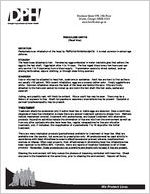Georgia Department of Public Health
Peachtree Street NW, 15th Floor Atlanta, Georgia 30303-3142 www.health.state.ga.us
PEDICULOSIS CAPITIS (Head Lice)
DEFINITION Pediculosis is an infestation of the head by Pediculus humanus capitis. It is most common in school-age children.
ETIOLOGY The head louse attaches to hair. Females lay eggs embedded in water-insoluble glue that adhere the eggs to the hair shaft. Eggs hatch after 4 to 14 days. The lice ingest blood every few hours and can only survive 1 to 2 days away from a blood supply. Transmission occurs by direct contact, such as sharing hairbrushes, caps or clothing, or through close living quarters.
DIAGNOSIS Lice or nits may be attached to head hair, eyebrows or eyelashes. Adult lice are hard to find as there are usually <10/patient. With recent infestation, eggs are a creamy-yellow color. Empty eggshells are white. Common infestation sites are the back of the head and behind the ears. Nits are firmly attached to the hairs and cannot be moved up and down the hair shaft like hair casts, scales and dandruff.
Itching, and possibly rash, will likely be evident. Nits or adult lice may be seen. There may be a history of exposure to lice. Small red papules or secondary excoriations may be present. Occipital or cervical lymphadenopathy may be present.
TREATMENT
Treatment should be considered only if active head lice or viable eggs are observed. Once a confirmed diagnosis of head lice infestation is made there are several treatment options to choose from. Methods include mechanical removal, treatment with pediculicides, and topical treatment with alternative products. Adjunctive activities include the elimination of lice and nits from the environment as well as from any other contacts who also have head lice, regular reinspections for lice and nits after treatment, and, if indicated, the reapplication of a pediculicide 7 to 10 days after the initial treatment.
There are many medicated products (pediculicides) available for treatment of head lice. Most are available over the counter, but some are by prescription only. All products must be used strictly in accordance with label directions to ensure effectiveness and prevent adverse reactions from overuse or misuse. When used properly, their effectiveness in eliminating head lice infestations has been reported to be 80% to 95%. However, there are reports of localized resistance to all of these products. Remember, these products are not preventive and should only be used if lice are present.
Cleaning the environment will help reduce the chances of becoming reinfested with head lice. Check everyone in the household at the same time, prior to cleaning the environment. Vacuum all floors,
We Protect Lives.
Georgia Department of Public Health
Peachtree Street NW, 15th Floor Atlanta, Georgia 30303-3142 www.health.state.ga.us
rugs, pillows, carpet squares, and upholstered furniture. Combs and brushes used on an infested individual should be immersed in water hotter than 130F, Lysol, rubbing alcohol or a pediculicide for one hour.
Play clothes, linens, smocks and cloth toys worn or handled by an infested individual within two days before diagnosis should be washed in water hotter than 130F, or machine dried at the highest heat setting for at least 30 minutes.
INFORMATION FOR SCHOOLS
1. Contacts should be treated only if infestation is found. 2. Avoid unnecessary re-treatment because of the toxic hazard. 3. Children can return to school following initial treatment. 4. Itching may persist for 1-2 weeks even after adequate treatment, and should not be considered
a reason for reapplication of medication. 5. Educate about the person-to-person mode of transmission, and procedures to prevent
transmission.
FOLLOW-UP Reevaluate in one week if symptoms persist. Re-treatment may occasionally be necessary. Use an alternate regimen if the infestation is not responding to treatment.
ADDITIONAL INFORMATION
CDC - http://www.cdc.gov/parasites/lice/head/index.html http://www.cdc.gov/parasites/lice/
The National Pediculosis Association - http://www.headlice.org/
Nemours Foundation - http://www.kidshealth.org/parent/infections/common/lice.html
We Protect Lives.
